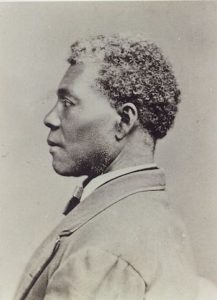
Archer Alexander
*The birth of Archer Alexander is celebrated on this date in c. 1810. He was a former slave and laborer who served as the model for the emancipated slaves in the Emancipation Memorial in Washington, D.C. He was the subject of an 1885 biography, The Story of Archer Alexander, written by William Greenleaf Eliot.
Archer Alexander was born a slave near Richmond, Virginia, on the plantation of the Ferrell family in Fincastle, Virginia. Ferrell sold Archer's father to pay off debts while Archer was still a child, but shortly thereafter, his new owner died and left Archer Alexander to his son, Tom Ferrell, who moved to Missouri in 1831, taking his slave with him. Alexander's mother, left behind in Virginia, died only a few months later.
Ferrell hired Alexander to local brickyards in St. Louis until he needed even more money when he sold Alexander to a farmer named Richard H. Pitman in St. Charles County. Alexander had married an enslaved woman named Louisa, whom James Naylor owned, and she accompanied him. Alexander was purchased in 1844 and worked for the same master for over twenty years. Naylor respected him, and he was responsible for functioning in an overseer capacity on the farm. During this time, Archer and Louisa Alexander became the parents of several children.
Alexander was determined to flee from his life in slavery. In 1861, during the American Civil War, he covertly notified a group of Union troops that Confederate sympathizers had sabotaged a bridge they intended to use. He became a suspect and had to flee. Slave catchers captured him, but he broke free and returned to St. Louis, where he obtained employment under the protection of the Federal provost marshal.
He looked for work in one of the public markets. Eliot (the book author's wife) was also there, having come to hire a servant. She hired Alexander and brought him home. Alexander proved discreet about his recent history, leading Eliot to suspect that Alexander was an escaped slave. Eliot managed to keep him safe until the Emancipation Proclamation was issued. Alexander and his wife were reunited, if only for a short time. In 1866, Louisa died.
In 1869, Eliot was working with a group to build a statue of Lincoln. The funding for an Emancipation Memorial featuring a statue of Lincoln had begun with a $5 donation from a former slave, Charlotte Scott, from Virginia. All the initial funds were from donations from former slaves, later matched by donations from The Western Sanitary Commission, a St. Louis-based volunteer war relief agency. Thomas Ball had an acceptable model made, but Eliot's group wanted to have a real freedman pose for it. Eliot gave Ball a photo of Alexander, and he was chosen as the model.
In 1876, the statue was unveiled, with several notable people in attendance, including President Ulysses S. Grant, cabinet members, Supreme Court justices, other government figures, and Frederick Douglass, another former slave. However, neither Alexander nor Eliot was present.
Death and aftermath
Archer Alexander died in St. Louis, Missouri, on December 8, 1879. Eliot and his son, Christopher, were with his friend Alexander, and Archer gave Christopher a gold watch to teach him how to read. Eliot noted that Alexander died, thanking God that he had died a free man. According to DNA research, Muhammad Ali's paternal grandmother was Alexander's great-granddaughter.
